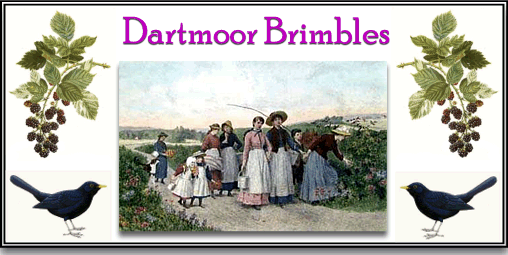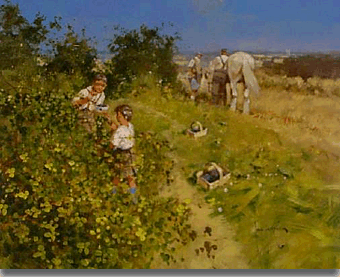
To this day I can still remember when, as a boy, Granfer would produce the dreaded ‘yeller pail’ and I was told, “go fill ‘un bwoy.” There wasn’t much I hated doing but filling that sodding ‘yeller pail’ used to ‘hack I orf’ no end because it meant one of two things. Either going down the verges picking dandelion heads or scratting around the hedgerows for blackberries, the former meant yellow stained, bitter tasting fingers and the latter, scratches that made it look as if you’d gone ten rounds with a tiger. The harvest from both crops went into a lethal distillation that went under the loose heading of ‘home-made wine’ or ‘jollup’. The only bonus of the blackberries were that any surplus went into superb, finger-licking jam or hot steaming pies. Yes, those were the good old days, and just to digress, I was walking down the lane a day or so ago and came across some cowslips which although they seem to be coming a commoner sight are still not as abundant as they were 30 years ago. Those little yellow flowers reminded me of being sent off to pick them for Granfer’s wine making – yes cowslip wine and the crazy thing is that today it is illegal to even pick one flower. Anyroad, I was on about blackberries and bramble bushes, or ‘brimbles’ as they are called on the moor.
Obviously the brimbles grow on the lower moorlands and are, as everywhere a common sight in the hedgerows’. They are also a common feature of superstitions and folklore, especially the time after the berries ripen or ‘blackberry time’. Depending on the local climate this was usually between late August and early October and a common belief was that after Michaelmas Eve (September 29th) you should never pick or eat a blackberry because on that night the Devil would pee on them and the consequences would be dire. This tradition can be found all over Devon but the timing varies as does what the Devil did to the berries which ranged from cursing, spitting and peeing on them. It is thought that this idea stems from the story of how when the Devil was cast out of Heaven he fell to earth and landed in a brimble bush. As he was trying to extricate himself from the clutches of the tangle of thorns he cursed the bush. Every year since that event he spoils the berry crop on the anniversary of his landing by spitting etc on them.
Apart from the obvious use of the berries that actual brimbles served many purposes, firstly it was an ideal plant to have in a hedge as next to hawthorn it made an ideal stock-proof barrier. The long tendrils were also used to make twine which was often used in broom and basket making. The thorns would be removed and the tendril split and twisted, the end result was an amazingly strong length of twine. Brimble roots were crushed and used to make a yellowy-orange dye that was utilized in the wool and cloth industries. There is also an old story of how a long length of brimble would be cut and the thorns removed from all bar the last 3 – 4 inches. This was then shoved down a rabbit hole in a twisting, ‘corkscrew-like’ manner until it would go no further. Then with a few extra twists the brimble would be dragged out the hole with, hopefully, a rabbit that had been ensnared by the thorns on the end, hmmm.
I recently recieved an email from someone who asked what a ‘brimbletapper’ was because he came across the term in a census of 1861, it was recorded as an occupation of a 67 year old gentleman from Islington who worked for a local farmer. I have never come across this term and would be grateful to hear from anyone who can enlighten me.

Blackberry time was also know as a period when illnesses both in humans and animals increased. An old saying from Hennock was, “Baby’s not well, ’tis blackberry time,” of the animals it was thought that horses, cats, and chickens suffered worse.
Both brimble and berry have for centuries been used in various charms and cures. At North Tawton there is a story of a mother who took he daughter to the local doctor and said the girl was suffering from sore eyes. When asked why she was covered in scratches the mother related that she had tried to cure the girl herself by dragging her backwards through an arched brimble bush three times after which she got the ‘old duck’ to ‘quack’ in her mouth three times. It was once said that to cure a wart the first seen blackberry of the season should be picked and rubbed over the wart and then thrown away. As the berry either rotted away or was eaten by some bird or animal the affliction would disappear. The brimble leaves when steamed and made into a drink were used to cure diarrhoea in children, as too would the green berries when eaten. Similarly, an ounce of fresh leaves infused in boiling water and drunk both night and morning could relieve the symptoms of shingles. Blackberry jam mixed into a cup of hot water was said to be a good cure for a sore throat, especially if blended with a little whisky. I reckon I should have complained of a sore throat before being sent out blackberry picking, at least the whisky might have dulled the senses against the bite of the thorns.
Occasionally the brimble occurs in Dartmoor place-names such as Brimbley Ford and Brimley Farm and Lane plus a smattering of the ‘Bramble Cottages’.
Today, you do not have to wait for the berries to ripen, you don’t even have to suffer a good ‘thorning’ to get the fruit, you simply wander down to Tesco’s and buy a punnit of weird looking things any time you fancy. Sad, isn’t it? this global world of, “I want it, and I want it now,” has taken away all the various seasonal treats and expectations. But what is more satisfying, sitting down and sipping a glass of home-made blackberry jollup as you inspect the exacted toll of thorny scars or eating a pie made of some insipid tasting, exotic mutation masquerading as a blackberry that has flown more miles than a moon shuttle.
I still have to this day, Granfer’s blackberry jollup recipe and should anybody wish to make some, here’s how he did it:

Ingredients:
6lbs blackberries (kilograms had not been invented)
1 lemon
1 gallon boiling water (litres were things that kept the church warm)
4lb sugar
1 good slug of brandy (which knowing Granfer would have been a bottle but a small glass will adequately suffice)
Yeast
Method:
1) Wash blackberries, rind the lemon and slice thinly and put into a large bowl; pour over the boiling water.
2) Cover and ‘let un bide’ (stand) for three days, stirring daily.
3) Strain on to the sugar through muslin and stir well. Add the lemon juice and previously activated yeast.
4) Leave for a day in a warm place, then pour into a demi-john with an airlock.
5) Ferment out. Siphon-off, bottle, and remember – patience is a virtue!
 Legendary Dartmoor The many aspects past and present of Dartmoor
Legendary Dartmoor The many aspects past and present of Dartmoor

One comment
Pingback: Ep. 40 – Celtic Monsters: Banshees, sluagh, sidhe, and more! | The DispatchIst: A Friendly Podcast about Hell